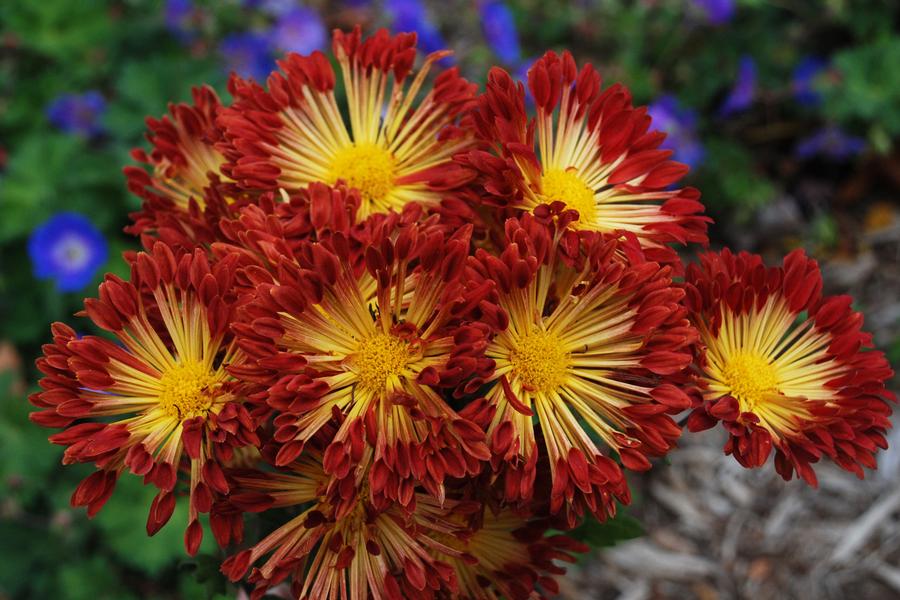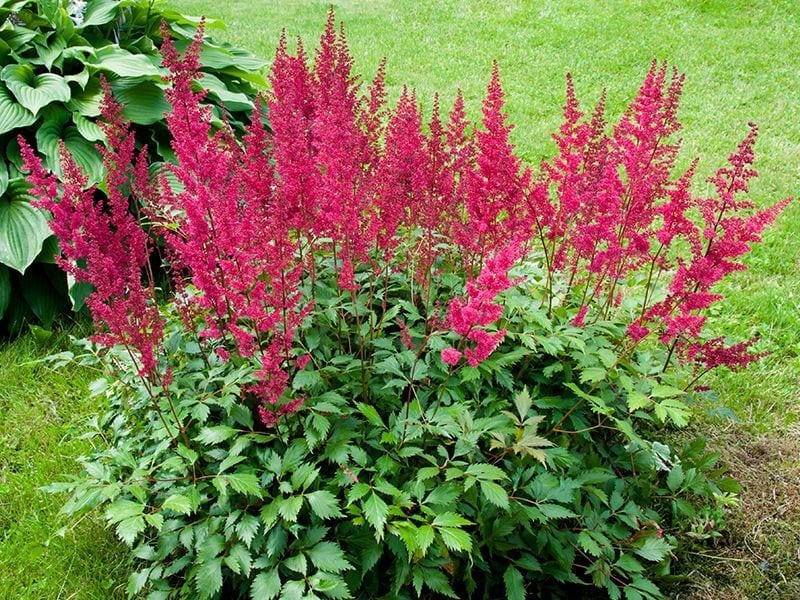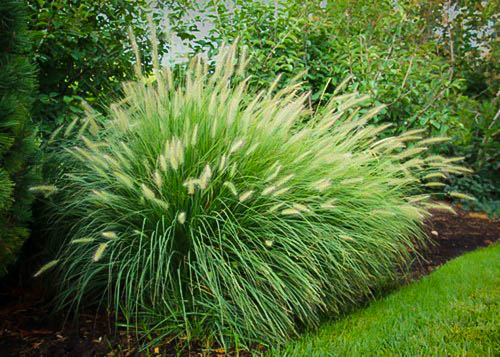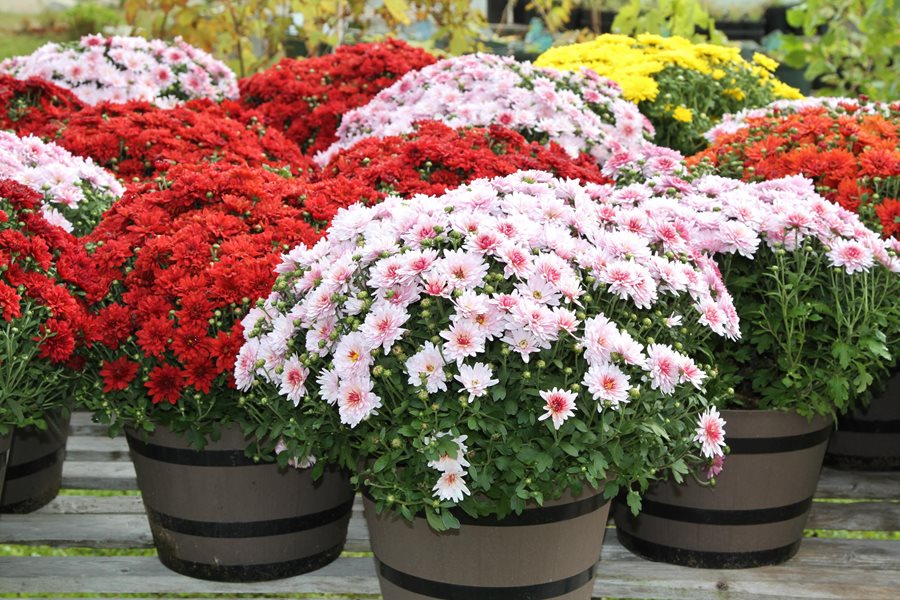Brightly colored fall chrysanthemums, or "mums," are hard to miss as summer winds down and fall approaches. They can be purchased just about any place that sells plants, from garden centers to grocery stores. It's easy to find mums in fall hues of yellow, bronze, purple or burgundy, but they also come in white, pink and red. These plants can either be planted in containers and hanging baskets or stuck into the ground to fill gaps in the garden. Regardless of how they are used, do not expect them to survive the winter. The fall blooming mums that can be purchased late in the growing season have not been bred for cold hardiness.
If they do manage to live through the winter, they seldom bloom again. It is almost always easier to treat them as annuals and add them to the compost heap after the first hard frost. Mums prefer a sunny spot in the garden with well-drained soil. Avoid locations where water stands after a heavy rain. To get the best bloom on large-flowering types, pinch off all the buds in late May.
This will encourage more compact growth and additional blooms. In northern parts of their range, apply a winter mulch to protect mums from sub zero temperatures. If your mums grow too large, divide them in the early spring every two to three years. After a few years some mums may begin to weaken or die out. Add new plants every year or two to keep the fall color show going. Planting chrysanthemum in the spring gives the perennial plant time to establish and adapt to its new garden home.
You'll easily find mums in garden centers and nurseries in both fall and spring, but planning ahead is key to successful planting. Planting in the spring will also result in a bigger bloom the following season. Although some fall mums can survive winter if planted immediately, the odds are much better with spring-planted mums. Your best option for keeping those mums alive year-round is to choose potted mums that are hardy enough to be grown as perennials. These potted mums are sometimes marketed as "garden mums" instead of "florist mums." Chrysanthemum 'Saxapahaw' is mum that features rose flowers with yellow centers.
Chrysanthemum 'Jessica' is another perennial mum hardy in USDA zones 5 through 9. It features heavily ruffled, bright yellow blooms. Best grown in humusy, fertile, consistently moist, well-drained soils in full sun. Tolerates very light shade, and appreciates some afternoon protection from the hot sun in southern climates. Pinch stems back as needed from late spring to mid-summer (e.g., Memorial Day to the 4th of July) to control height and to encourage bushy vegetative growth. For best bloom, feed plants several times during the growing season.
Cut plants back to 6" after flowering and mulch (e.g., straw or evergreen boughs) for winter. Divide as needed (usually every 2-3 years) in spring or fall. In cold winter climates such as the St. Louis area, plants given winter protection will usually survive, but not always. Winter hardiness can vary considerably from year to year and from location to location within the same hardiness zone. Gorgeous mums in shades of red, yellow, orange, purple, and white pop up everywhere in the fall.
I like to use them for autumn displays on my porch, along with dried cornstalks, gourds, and pumpkins. But by the following spring, my plants are usually reduced to clumps of dead stems. After checking in with a few mum-growing pros, I realized I was planting my mums too late. In fact, garden mums are fairly easy to grow, once you know the following common mistakes to avoid. Plant mums as soon as the soil warms in the spring.
From late spring to mid-summer, pinch back the tips and flower buds on all shoots to make the plant bushier and prepare it for a dramatic fall show. For optimal blooming, the plants should be fertilized regularly throughout the growing season. After the blooms fade, cut the plants down to about 6 inches, and cover them with straw or another dry mulch to protect the roots over winter. Established plants should be lifted and divided every two to three years. I call the potted mums that make it through the winter my "surprise" mums. I can never decide which mum colors I like best, so I usually end up buying a rainbow of pink, lavender, red, bronze, yellow, gold and white for fall decorating.
By the time I've uncovered and/or replanted several winter survivors in the spring, I don't remember what color flowers any particular plant will produce. It's a lovely surprise in the fall when each mum's tightly closed buds finally open to reveal their color. Because these flowers have developed in my garden instead of being forced into bloom at a nursery, they seem to be extra tough. The fact that I have pinched them back until mid-summer causes the mums to open late -- not before October. Occasionally garden mums do winterkill, especially if the soil drains poorly or if there are excessive temperature fluctuations in the winter.
Since mums have shallow root systems they are very easily damaged by freezing and thawing. This type of winter damage can be prevented with mulching and proper care in the fall. Garden mums are much more likely to survive the winter if the dead plant stems are not removed until the spring. Additionally, adding a 2-4-inch layer of mulch over the crowns of plants can help. Pine needles, shredded bark, clean straw or evergreen boughs work well, but avoid leaves as these flatten and provide very little insulation.
Remove the mulch once the ground thaws in April and cut back dead stems before new growth begins. Mums aren't exactly "pruned," but are instead pinched throughout the growing season. This helps the plant branch out, become fuller and offer more blooms. When your plant reaches 6 inches tall in the spring, simply pinch off 1 inch of each shoot.
Repeat this every 2 to 3 weeks until early summer.Deadhead spent blooms throughout the fall for an extended bloom time. Once the plant has died in the winter, resist cutting it back. Research reveals that allowing it to die back naturally over the winter produces a stronger plant.
Simply clean up the dead stems and foliage in the spring. Plant the mums in well-draining soil that receives full sun. If the mums produce spring blooms, pinch them back before late summer to encourage fall flowering.
Before winter, cover plants with several inches of mulch or straw. One option is to try to overwinter the mums by burying the pots in the garden. Cut back the dead foliage to the surface of the soil and bury the pot up to the edge. A layer of mulch on top of the pots will also help keep the roots warm. In the spring, if the mums start showing new growth, you can dig them up and set them out in the sun or plant them properly in your garden. Department of Agriculture plant hardiness zones 5 through 9, but this varies by species and variety, according to the University of Vermont.
Most are simply grown as annuals -- especially those in pots. When I first began to grow hardy mums, I was delighted to discover that this genus offers tall selections , which can be used to round out a planting and add variety. I can think of no better one to start with than Chrysanthemum 'Emperor of China' (Z 4–9). Reaching a height of 3 to 4 feet, this selection has dark pink buds that form beautiful double flowers, which are pink with dark centers. The 1½-inch-wide blooms with quilled petals open quite late, usually not until the third week of October, but they last until Thanksgiving if there is no killing frost. 'Emperor of China' can appear lanky, so I recommend placing it in the middle or back of the border or pinching it in late spring.
Amy Enfield, a horticulturist for Miracle-Gro, says garden mums should be planted outdoors by late summer or early fall, so the roots have time to form before the soil freezes. Also known as hardy or Belgian mums, garden mums are sold in garden centers and nurseries, and they're perennials in USDA Zones 5 to 9. But even when they're planted at the right time, they need a few other things, like excellent drainage. Enfield adds, "There's no guarantee they will survive the winter, particularly the further north you live in the U.S." If you live in a cold climate, it is best to leave the foliage on the plant, even after it has browned and died, to increase the plant's chance of surviving the winter.
In spring, you can prune out the dead leaves before the new ones start to develop. That's what you'll get when you put a generous helping of chrysanthemums in your flower border or containers. Generally sold in ready-to-bloom form, mums provide a fall finale of color to any setting.
They come in a wide variety of flower colors and shapes, from small button-sized blooms to giant corsage-worthy flowers. Mum colors include white, yellow, pink, orange, red, burgundy, cream, salmon, and bi-color. There are also dwarf forms that grow just 8 to 10 inches tall and standards that can reach 3 feet in height. Mums are very popular with bees and butterflies, too. Add vibrant late summer and fall color to your flower beds with mums. Also called chrysanthemums, mums are an easy-to-grow, low maintenance perennials that provide late season color when many other perennials are done flowering for the season.
In the fall, flowers cover the plants creating a vibrant display. These sun-loving perennials are so big, they can be used like small shrubs to line a walkway. Mums prefer well-drained soil and a sunny location. Mum plants can be planted in partial shade, but perform best with several hours of direct sunlight daily.
If you want to grow a perennial chrysanthemum, purchase hardy, named varieties and plant them in the ground in full sun on well-drained soil. Container plants should be moved to a protected spot in winter. Plant mums at least 6 weeks before your first killing frost in fall. That's usually early- to mid-September, depending on your location.
Leave the foliage on the plant after frost so it can catch blowing snow for winter protection. You can also cut it back to the ground and pile bark mulch on the plant to protect the roots. Garden mums are readily available in a wide range of colors for purchase now and a great way to add late season color to your garden. You may also see the terms "hardy mums," "fall mums" and "chrysanthemums" used for these plants at garden centers. Non-potted mums should ideally be planted in the spring. This gives them time to establish deep roots before they start blooming.
Technically, however, they can be planted in your garden any time before the first frost of fall. This means you can try removing the mums from your pot and planting them in the ground in the fall. Although your potted mums may look dead, they might just be dormant. Keep in mind, however, that they might not sprout again the following spring. Cut back the foliage to the surface level of the soil and always use sterilized pruning tools so you don't transfer disease to the mums. Choose a location that is in full sunlight and has rich, well-draining soil for best results.
Plant them at the same depth as they were in the pot and water them thoroughly after planting. My first experience with overwintering a chrysanthemum was a happy accident. After my garden center mums were done blooming at the end of the fall, I removed them from their pots and tossed them into the compost pile. The following spring, I was surprised to find healthy new chrysanthemum leaves sprouting from the sides of the pile. By placing the mums' roots in a protected spot, I had inadvertently provided just the right winter environment for my forgotten plants. I have since gone on to try overwintering potted mums in the ground.
Even in my zone 5 garden, these plants often make it through the winter. Plants should be inches apart to allow for good circulation and to cut down the chances of powdery mildew. When the plants come up in the spring, let them grow to about 4 inches tall and then pinch the top off each shoot, leaving about 3 to 4 leaves on the stalk.
Do this about every other week or so until the July 4. When you stop pinching them, they will set flower buds on well-formed, compact plants. Failure to pinch, results in leggy, floppy plants. You can keep the plants attractive by deadheading spent flowers. Do not cut the plants to the ground at the end of the season.
I know it looks ugly, but the crown of the plant is protected by its dead stalks. Add some mulch around the plants and wait until spring to remove the old plant material. Finally, keep in mind that the fall mums sold in garden centers nowadays aren't the same kinds of plants sold 20 years ago, Enfield says. Although garden mums are considered hardy to Zone 5, breeders have developed fall mums with big mounds of showy flowers.
This has resulted, she says, in plants that may not be as cold hardy as in the past. So, if your fall-planted mums don't come back like true perennials, just treat them like annuals. Replace them with beautiful, fresh plants when you're ready to do your fall decorating and enjoy their colorful blooms for a season.
In moderate climates, that is hardiness zones 6 to 9, the most popular fall perennial is the garden chrysanthemum, often called cushion mum, fall mum, or garden mum. In colder climates, though, chrysanthemums haven't shown themselves to be particularly hardy and many gardeners have learned to treat them as annuals. Fortunately, there are now extra hardy garden mums to try, ones well adapted to climates as cold as zone 3. Single daisy-like apricot pink flowers with golden yellow centers cover this plant with a profuse bloom from late summer to frost.
Although it is tempting to buy those huge beautiful fall mums you see during the autumn season, in terms of longevity, the smaller spring mums are actually a better investment. Fall flowers are your reward for planting mums in the spring and allowing them enough time after pinching or trimming to reach their potential. Just because you plant your mums late in the season, doesn't mean they won't overwinter.
However, giving them a month or so before frost sets in to root into the soil well will make for a better yield of flowers. An alternative to overwintering plants in a garden bed is to dig them up and put them in cold frames to ensure survival. Garden mums (Chrysanthemum spp.) are herbaceous perennials in the daisy family and are stalwarts of the flowering autumn garden. When garden centers sell blooming potted mums in the fall, they are usually used as annuals and discarded when the blooms fade. And when gardeners try to transplant these mums into the ground late in the season, chances are they won't make it through winter and become perennial. Although garden mums are often called hardy mums, they may not survive the winter if drainage is poor or if you live in an extremely cold climate.




























No comments:
Post a Comment
Note: Only a member of this blog may post a comment.